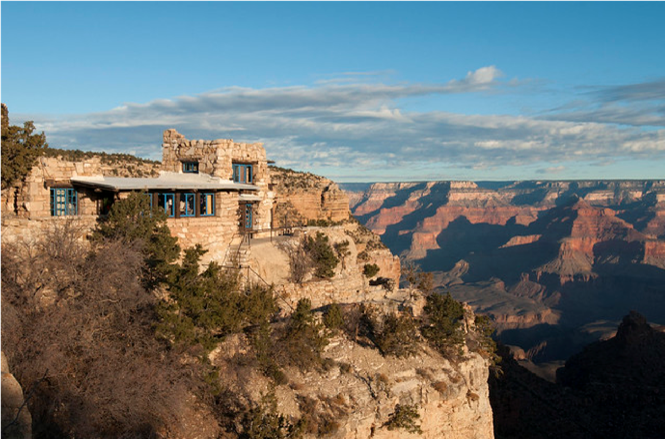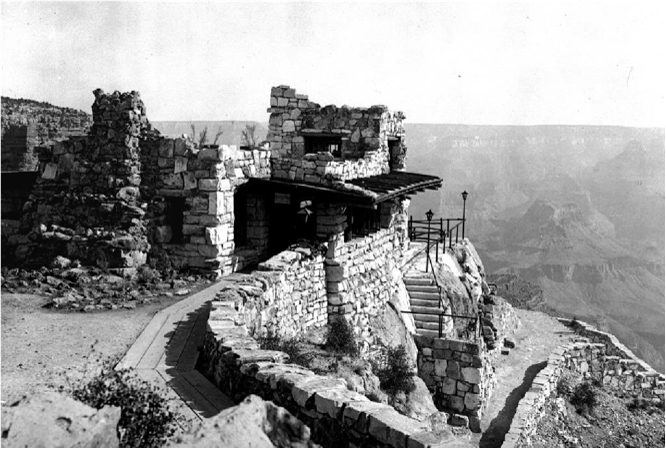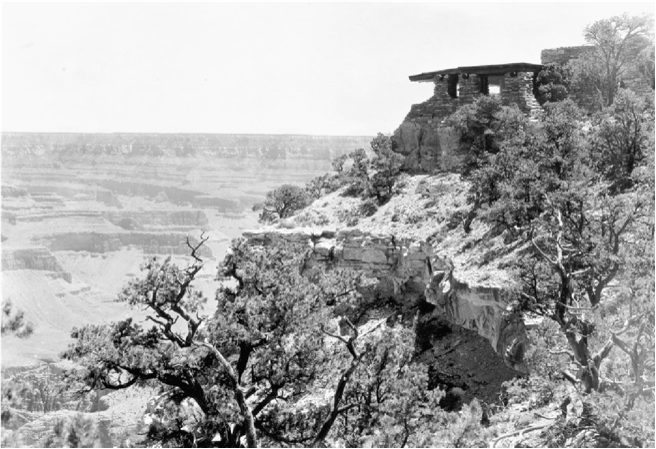Linda Reeder
Central Connecticut State University, New Britain, Connecticut
reederlin@ccsu.edu
Summary Statement
Mary E. J. Colter designed and supervised the construction of The Lookout,[1] a rest house and observatory on a promontory of the Grand Canyon, in 1914. Built of “rough hewn stone quarried on the spot,”[2] its irregular roofline echoes the geologic formations of the canyon below. Soon after its completion, The Lookout was described as seeming “a part of the rim itself.”[3] Referencing archival documents and images, this paper will examine The Lookout in the context of its integration with the Grand Canyon. It will describe how this continuity mediates a connection between visitors and the canyon and explore how this connection influenced a quarter century of National Park Service (NPS) architecture.
Background
In the late nineteenth century, non-indigenous people began traveling to the Grand Canyon for its mineral resources and natural beauty. Tourism expanded in 1901 when the Atchison, Topeka & Santa Fe Railway completed a spur line to the south rim. During a 1903 visit, President Theodore Roosevelt called the Grand Canyon an unparalleled natural wonder and said, “Leave it as it is. You can not improve on it. The ages have been at work on it, and man can only mar it. What you can do is to keep it for your children, your children’s children, and for all who come after you.”[4] In 1908 Roosevelt declared 800,000 acres of the Grand Canyon a national monument, permanently protecting it.
The Santa Fe Railway built The Lookout to provide visitors with a rest house from which to gaze at the canyon during the day and the stars at night. It was part of the development at the Grand Canyon completed in anticipation of large crowds stopping over on the way the 1915 Panama Pacific Expositions in San Francisco and San Diego. The railway promoted all three destinations and passenger traffic continued to grow.5
The Divine Abyss and The Lookout
In his 1912 essay “The Divine Abyss,” nature writer John Burroughs described his awe upon viewing the Grand Canyon: “The immensity of the scene, its tranquillity, its order, its strange, new beauty, and the monumental character of its many forms–all these tend to beget in the beholder an attitude of silent wonder and solemn admiration.”6 Burroughs repeatedly described the canyon’s natural features in architectural terms, concluding, “Indeed, there is such an opulence of architectural forms in this divine abyss as one has never before dreamed of seeing wrought by the blind forces of nature. These forces have here foreshadowed all the noblest architecture of the world.”[5]
Colter designed The Lookout as an architectural extension of the canyon wall itself. This integration was primarily achieved through material, shape, and an impression of permanence. The building’s irregular profile mimics features of the canyon using the same limestone as the promontory on which it sits. When the structure was new, plantings on the roof lent it a sense of timelessness (Figs. 1-2).

Fig. 1. Lookout Studio in 2012. (NPS photo by Kristen M. Caldon)

Fig. 2. South entrance to The Lookout, c. 1915. Note the plants growing on the roof. (Fred Harvey, GRCA 09722A, courtesy of NPS)
A balcony held a powerful telescope, but “Views through a telescope can never take the place of a descent into the canyon,” a 1915 Santa Fe brochure stated, “as it is only from below that its depth and magnitude can in any measure be comprehended.”[6] A series of terraces and stairs leads from the southern door of The Lookout down into the canyon (Fig. 3). This pathway not only anchors the building to its site; it also connects visitors to the canyon both physically and visually. This continuity with the site through different vantage points offers visitors the tangible means to appreciate the canyon’s overwhelming size and beauty in comprehendible portions.

Fig. 3. East elevation of The Lookout with visitors viewing the canyon from different levels, c. 1915. (Fred Harvey, GRCA 11821, courtesy of NPS)
Rustic Architecture in the Parks
“Since at least the 1880s,…[v]irtually everyone involved in early national park management …agreed that proposed architectural development should ‘blend’ and ‘harmonize’ with its surroundings,” writes landscape architect Ethan Carr. This aesthetic was consistent with the naturalistic landscape design for municipal and regional park developments at this time.[7]
While Colter was not the first to design a rustic building in a remote location, others had relied on variations on an Adirondack or Swiss Chalet style of wood or timber buildings to blend in with the natural environment (Fig. 4). In contrast, Colter took her cues from the landscape at the canyon’s rim. In his article about place and aliveness, Peter Buchanan writes:
Creating place – environments with a distinct sense of place (of being somewhere memorably distinctive that is rooted in and shaped by the many specificities of its larger setting) – is an essential aspect of how we have made a home for ourselves on earth, and so also of how we made the earth our home.
… But place, like aliveness, is something we recognise intuitively rather than intellectually, and both might even be recognized by the feeling stirred in us when we open up to engage empathically and experience rather than merely detachedly observe or rationally contemplate….This is…pattern as an irreducible perceptual gestalt that confers on a building a distinct physiognomy, a sense of stability and wholeness, and raises it from useful, subservient artefact to a being in its own right.[8]
Because of the strong sense of place created from its unity with the canyon, The Lookout enhances the experience of Grand Canyon visitors.

Fig. 4. El Tovar, the Santa Fe’s luxury hotel, in 1912. It was designed by Charles Whittlesey and opened in 1905. The Lookout was built less than 0.25 miles from this hotel. (GRCA 09536, courtesy of NPS)
Continuity and Parkitecture
After the Grand Canyon National Monument became a national park in 1919, the NPS’s first landscape architect met with Colter and studied the structures at the Grand Canyon, including three designed by Colter.[9] Colter’s innovative design expressing The Lookout’s continuity with the canyon contributed to the development of the style of architecture that came to be known as National Park Service Rustic,12 or less formally, “Parkitecture.” Colter’s influence on architecture and place-making in the parks is undeniable. For example, in 1928, Herbert Maier designed a rim-side observatory two miles from The Lookout that is widely acknowledged as indebted to “the architectural standards Colter had set for ‘rim zone’ development.”[10] (Fig. 5)
Rustic architecture was widely employed throughout the national park system into the 1940s.[11][12] The continuity with the landscape achieved by many of these park structures represented a shift in the hierarchy between nature and buildings typical in other settings. “Perhaps for the first time in the history of American architecture, a building became an accessory to nature,” NPS Historical Architect Merrill Ann Wilson wrote.1[13] By requiring that buildings, roads, and other improvements harmonize with the landscape,[14] the NPS sought to maintain the natural state of the parks for future generations. The new developments improved the visitor experience without detracting from the natural experience. At its best, parkitecture mediated a connection between visitors and nature. As the NPS’s first director said, “[N]atural scenery…makes better men and women physically, mentally and spiritually.”17

Fig. 5. Herbert Maier used architectural standards established by Colter’s The Lookout for the design of his 1928 rim-side observatory. (Photo c. 1929. GRCA 09766, courtesy of NPS)
[1] Don P. Johnston and Aldo Leopold, Grand Canyon Working Plan: Uses, Information, Recreational Development (US Forest Service, December 1916; approved April 9, 1917): paragraph 35. Grand Canyon Museum Collection, GRCA 28343.
[2] “California and the Grand Canyon of the Arizona” (La Grande Station: Fred Harvey, 1914). Heard Museum, Billie Jane Baguley Library and Archive RC39(9A)3.
[3] Johnston and Leopold, Grand Canyon Working Plan, 1917: paragraph 35.
[4] Transcript of Roosevelt’s May 6, 1903 speech at the Grand Canyon (http://www.theodoreroosevelt.com/images/trenvpics/trgrandcanyonspeech.pdf, accessed September 26, 2016). 5 L. L. Waters, Steel Tracks to Santa Fe (Lawrence: University of Kansas Press, 1950): 396-398. 6 The Writings of John Burroughs: Volume 14, Time and Change (Boston: Houghton Mifflin Company, 1912), 46.
[5] Burroughs, 50.
[6] “The Lookout: Grand Canyon, Arizona” (Fred Harvey, 1915): 8-9. Grand Canyon Museum Collection, GRCA 27084.
[7] Ethan Carr, Wilderness by Design: Landscape Architecture & the National Park Service (Lincoln: University of Nebraska Press, 1998): 123.
[8] Peter Buchanan, “The Big Rethink Place and Aliveness: Pattern, Play and the Planet.” Architectural Review 232, no. 1386 (August 2012): 86–95. (http://search.ebscohost.com.ccsu.idm.oclc.org/login.aspx?direct=true&db=vth&AN=78344948&site=ehostlive&scope=site, accessed April 27, 2019)
[9] Department of the Interior, Report of the Director of the National Park Service to the Secretary of the Interior for the Fiscal Year Ended June 30, 1919 (Washington: Government Printing Office, 1919): 266. 12 Linda Flint McClelland,Building the National Parks: Historic Landscape Design and Construction (Baltimore: The Johns Hopkins University Press, 1998): 112-14.
[10] Carr, 143.
[11] William C. Tweed, Laura E. Soulliere, and Henry G. Law,National Park Service Rustic Architecture: 1916-
[12] (National Park Service Western Regional Office Division of Cultural Resource Management, 1977): i-ii. 15 Merrill Ann Wilson, “Rustic Architecture: The National Park Style,” Trends, July August September 1976:
[13] .
[14] US Department of the Interior. Report of the Director of the National Park Service to the Secretary of the Interior for the Fiscal Year Ended June 30, 1918 (Washington: Government Printing Office, 1918): 274. (http://npshistory.com/publications/annual_reports/director/1918.pdf, accessed October 7, 2018) 17 Stephen Mather in American Civic Annual, I, 1929, as quoted in Wilson: 5.



